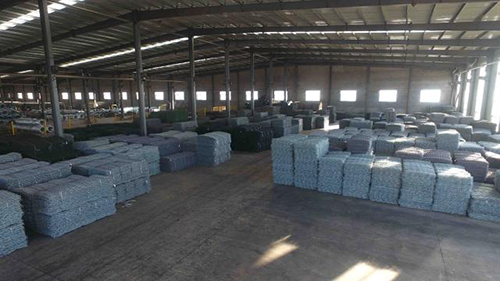Gabion is an ecological grid structure. In China, the ecological grid structure originated from the bamboo cage and sheep pen technology of more than 2000 years. Now, as a new type of ecological grid structure with new technology and new materials, it has been successfully applied to water conservancy projects, highways, railway projects, and dike maintenance projects, completing the organic connection between the engineering structure and the ecological environment. Compared with some traditional rigid structures, it has its own advantages. Therefore, in the world, it has become a very good structural form for preventing and controlling debris flows, maintaining river channels, managing landslides, and avoiding collapse, rock falling and other environmental problems. Gabion nets are widely used and have huge advantages. Then, how to construct gabion nets? Next, I will teach you nine steps to install gabion nets easily.
1. Put the gabion net on the staggered seams so as not to pass through the seams longitudinally.
2. Stand up the four sides of the gabion net, and lock the adjacent edges with tie wires. When tying the lock, wrap the tying wire around two overlapping frame lines (when sewing the edges) or twist the frame line and the double kink edge of the net cage (when sewing the grid) in a spiral shape to avoid serious galvanizing Damaged, and the pitch should not be greater than 50mm.
3. When the gabion net is installed on the finished bottom net, use the binding wire to fix it on the bottom gabion net along the lower frame of the newly installed gabion net. The adjacent gabion nets on the same layer are also fastened to each other with binding wires to make the gabion nets integrated.
4. When construction is carried out at the same level as a certain unit project, the gabion net should be completely in place before filling the pebbles. In order to avoid the deformation of the gabion net, two adjacent gabion nets (including the same gabion net) The height difference between adjacent cells) should not be more than 35cm.

5. Before the gabion net is installed, the bank slope and the ground should be properly trimmed, and the original shape of the bank slope should be maintained as much as possible, and there should be no obvious arches and depressions.
6. The filled pebbles are selected on the floodplain, and their compressive strength should meet the planning requirements. The particle size of the pebbles should be between 8-20cm, and the size should be reasonably adjusted to achieve the porosity required by the planning and to ensure the linear shape of the gabion net.
7. When filling pebbles in the gabion net, use pebbles with a particle size of not less than 10cm on the outside, and artificially place them to obtain a beautiful appearance and avoid water flow to wash away the pebbles from the mesh. The super-filled stone material should be guaranteed to be 2.5 ~3cm high to allow room for subsidence.
8. After filling the gabion cages with stones, put down the top cover, and then tighten the two overlapping frame lines with a tie thread, the pitch should not be greater than 50mm, tie the lock.
9. Pave 10-15cm of humus on the stone cage net which is good for the growth of vegetation.
Previous: YKM stainless steel wire mesh
Next: What Should You Pay Attention To When Using A Powerful Magnet?
Copyright:@2020-2021
Comments Please sign in or sign up to post.
0
0 of 500 characters used